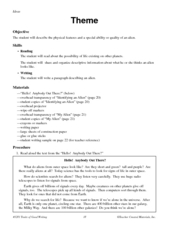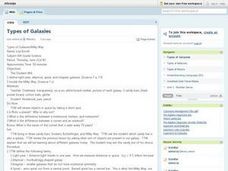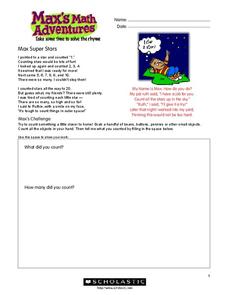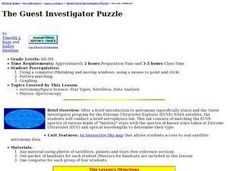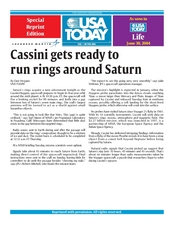Curated OER
Solar System
In this Solar System worksheet, 5th graders demonstrate knowledge of parts of the Solar System. Students unscramble letters to list these parts.
Curated OER
The Solar Cycle
Students research the solar cycle. In this Science lesson, students use the internet to investigate the solar cycle. Students produce a spreadsheet and graph from the information collected.
Curated OER
Sunspots: Correlating Sunspots to Active Regions
Students investigate sunspots. They use solar imaging from satellite instruments which are currently circling the sun. Students compare images from the satellites and determine the existence of a correlation between the two types of...
Curated OER
Planet/Constellation Mobile
Pupils, through small group discussion, identify and share a rationale for shapes and patterns in the construction of a mobile that represents the solar system that makes them think of the creation of our solar system.
Curated OER
Our Solar System
Third graders describe the composition of our solar system. They recognize the names of the planets in our solar system and compare and contrast the nine planets that orbit the sun.
Curated OER
My Alien
Students listen to text read from "Hello! Anybody Out There?" and then brainstorm what aliens from outer space look like and do they exist at all.
They then will describe the physical features and a special ability or quality of an alien.
Curated OER
Theme
Students examine a reading selection. In this descriptive writing lesson, students read an excerpt from "Hello! Anybody Out There?". Students discuss the idea of aliens living on other planets, describe what they think an alien looks...
Curated OER
Using the Internet
In this using the internet learning exercise, students search several websites to review information about the heart, human senses, the solar system, and planets. Students also read information about the rock cycle and answer provided...
Curated OER
Asteroids
Students examine the different types of asteroids and how they enter the atmosphere. In this space lesson students use mashed potatoes to create an asteroid they can eat.
Curated OER
Earth
Fourth graders have a spatial awareness of the plants by orally discussing what they saw after they stepped out the model of the solar system. They recognize the similarities and differences between Earth and the other planets by being...
Curated OER
How Big Are Earth, Sun, and Moon?
Third graders draw what they believe is in space on a dry erase board. In groups, they are given a beaker half filled with water and they add a teaspoon of oil, observing the different layers that form. To end the lesson, they identify...
Curated OER
Types of Galaxies
Eighth graders take a quiz to review the different objects in space. As a class, they define terms related to galaxies. In groups, they make a model of the Milky Way galaxy using materials provided to them by their teacher. To end the...
Curated OER
What is a black hole anyway?
In this black holes worksheet, students answer multiple choice questions about black holes in space. Students complete 4 multiple choice questions.
Curated OER
Solar System: Let's Take a Trip
Third graders consider outer space. In this introductory solar system lesson, 3rd graders complete a KWL chart and listen to the story The Magic School Bus: Lost in the Solar System, by Joanna Cole & Bruce Degen. They will contribute...
Curated OER
Max's Math Adventures
In this counting practice activity, students read the story rhyme about counting practice. Students count a handful of objects they find in their home. Students then count the objects illustrated in each picture set. Students also draw...
Curated OER
Mother Earth - Father Sky
Third graders research and write about Cyrus Dillan. They explain one of Dillan's sculptures. Students locate six constellations and two planets. They research and write about the daily life of the Pawnee.
Curated OER
The Guest Investigator Puzzle
Students conduct a brief astrophysics lab matching the EUVE spectra of various kinds of "mystery" stars with the spectra of known stars taken at Extreme Ultraviolet and optical wavelengths to determine their type.
Curated OER
Retrograde Motion
Students study the motions of the heavenly bodies. In this space lesson plan students use models to show a variety of schemes explaining the motions.
Space Awareness
Sun, Earth and Moon Model
The moon orbits Earth while the Earth is rotating, and the Earth revolves around the sun. This can be a tricky concept for young astronomers. Implement an activity that helps distinguish between the movements of Earth's systems around...
Curated OER
Tilted Earth
What causes Earth's seasons? Find out through a series of anticipatory questions, an easy yet powerful activity representing the sun-Earth system, a diagram to label, and follow-up questions. Dispel the misconceptions about Earth being...
Curated OER
The Impact
Students study different inventors and inventions. In this invention introduction activity students pretend that they are an inventor and come up with their own invention.
Curated OER
Cassini gets Ready to run Rings Around Saturn
Fourth graders study an article about Saturn. In this investigative lesson students discuss the article and complete an activity that asks them what question they would pose about Saturn.
Curated OER
Teachers' Notes: Switch Gets Ready!
Students practice multiplication facts, answer simple math questions from two, five, and ten times-tables, explore concept of halves and quarters, complete worksheet containing range of shapes to make shape picture, and sort data and...
Curated OER
What Makes Jokes Funny?
Explore how language is used for comic effect. Middle schoolers determine which of the three formulas for jokes (double meanings, unexpected outcome, humorous mental image) make each of 18 classic, corny examples funny. They complete a...








